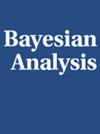Personalized Dynamic Treatment Regimes in Continuous Time: A Bayesian Approach for Optimizing Clinical Decisions with Timing
IF 2.5
2区 数学
Q1 MATHEMATICS, INTERDISCIPLINARY APPLICATIONS
引用次数: 11
Abstract
Accurate models of clinical actions and their impacts on disease progression are critical for estimating personalized optimal dynamic treatment regimes (DTRs) in medical/health research, especially in managing chronic conditions. Traditional statistical methods for DTRs usually focus on estimating the optimal treatment or dosage at each given medical intervention, but overlook the important question of “when this intervention should happen.” We fill this gap by developing a two-step Bayesian approach to optimize clinical decisions with timing. In the first step, we build a generative model for a sequence of medical interventions—which are discrete events in continuous time—with a marked temporal point process (MTPP) where the mark is the assigned treatment or dosage. Then this clinical action model is embedded into a Bayesian joint framework where the other components model clinical observations including longitudinal medical measurements and time-to-event data conditional on treatment histories. In the second step, we propose a policy gradient method to learn the personalized optimal clinical decision that maximizes the patient survival by interacting the MTPP with the model on clinical observations while accounting for uncertainties in clinical observations learned from the posterior inference of the Bayesian joint model in the first step. A signature application of the proposed approach is to schedule follow-up visitations and assign a dosage at each visitation for patients after kidney transplantation. We evaluate our approach with comparison to alternative methods on both simulated and real-world datasets. In our experiments, the personalized decisions made by the proposed method are clinically useful: they are interpretable and successfully help improve patient survival.连续时间的个性化动态治疗方案:优化临床决策的贝叶斯方法
准确的临床行为模型及其对疾病进展的影响对于医学/健康研究中评估个性化最佳动态治疗方案(DTRs)至关重要,特别是在管理慢性病方面。dtr的传统统计方法通常侧重于估计每次给定医疗干预的最佳治疗或剂量,但忽略了“何时进行干预”的重要问题。我们通过开发两步贝叶斯方法来优化临床决策的时机来填补这一空白。在第一步中,我们为一系列医疗干预(连续时间中的离散事件)建立了一个生成模型,该模型具有标记的时间点过程(MTPP),其中标记是指定的治疗或剂量。然后,将该临床行为模型嵌入到贝叶斯联合框架中,其中其他组件建模临床观察,包括纵向医学测量和治疗史条件下的事件时间数据。在第二步中,我们提出了一种策略梯度方法,通过MTPP与临床观察模型的交互来学习个性化的最佳临床决策,从而最大化患者的生存,同时考虑到第一步中从贝叶斯联合模型的后验推断中获得的临床观察中的不确定性。该方法的一个标志性应用是为肾移植后的患者安排随访,并在每次随访时指定剂量。我们通过比较模拟和现实世界数据集上的替代方法来评估我们的方法。在我们的实验中,通过提出的方法做出的个性化决策在临床上是有用的:它们是可解释的,并成功地帮助提高了患者的生存率。
本文章由计算机程序翻译,如有差异,请以英文原文为准。
求助全文
约1分钟内获得全文
求助全文
来源期刊

Bayesian Analysis
数学-数学跨学科应用
CiteScore
6.50
自引率
13.60%
发文量
59
审稿时长
>12 weeks
期刊介绍:
Bayesian Analysis is an electronic journal of the International Society for Bayesian Analysis. It seeks to publish a wide range of articles that demonstrate or discuss Bayesian methods in some theoretical or applied context. The journal welcomes submissions involving presentation of new computational and statistical methods; critical reviews and discussions of existing approaches; historical perspectives; description of important scientific or policy application areas; case studies; and methods for experimental design, data collection, data sharing, or data mining.
Evaluation of submissions is based on importance of content and effectiveness of communication. Discussion papers are typically chosen by the Editor in Chief, or suggested by an Editor, among the regular submissions. In addition, the Journal encourages individual authors to submit manuscripts for consideration as discussion papers.
 求助内容:
求助内容: 应助结果提醒方式:
应助结果提醒方式:


